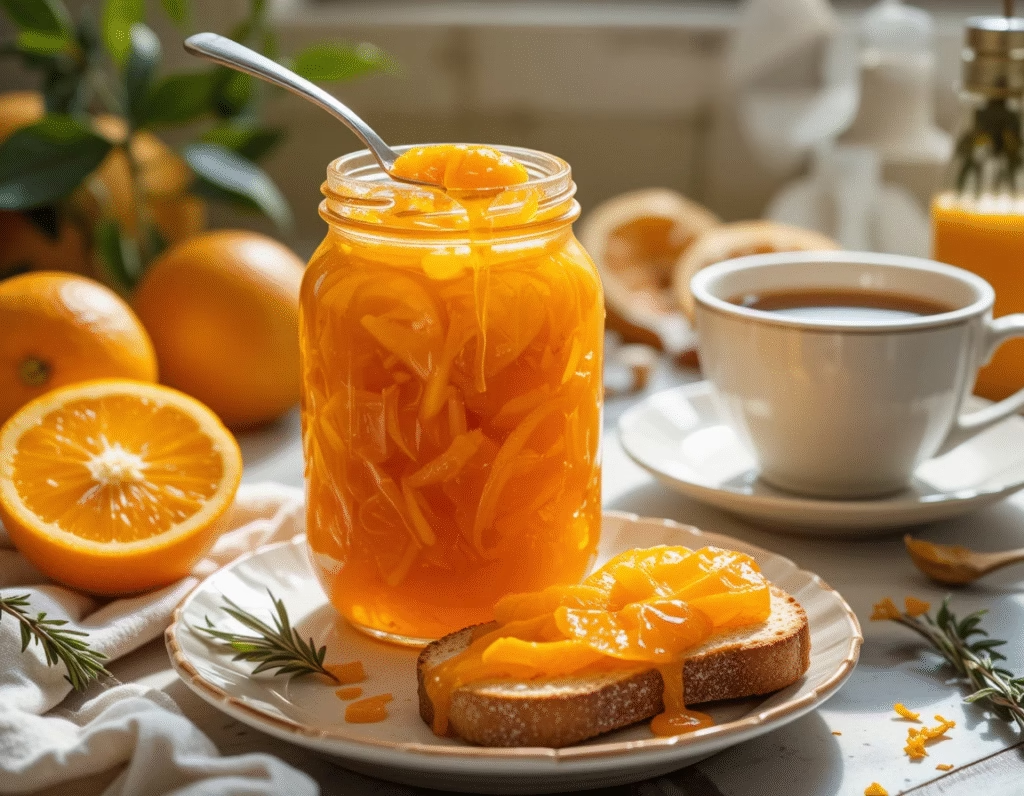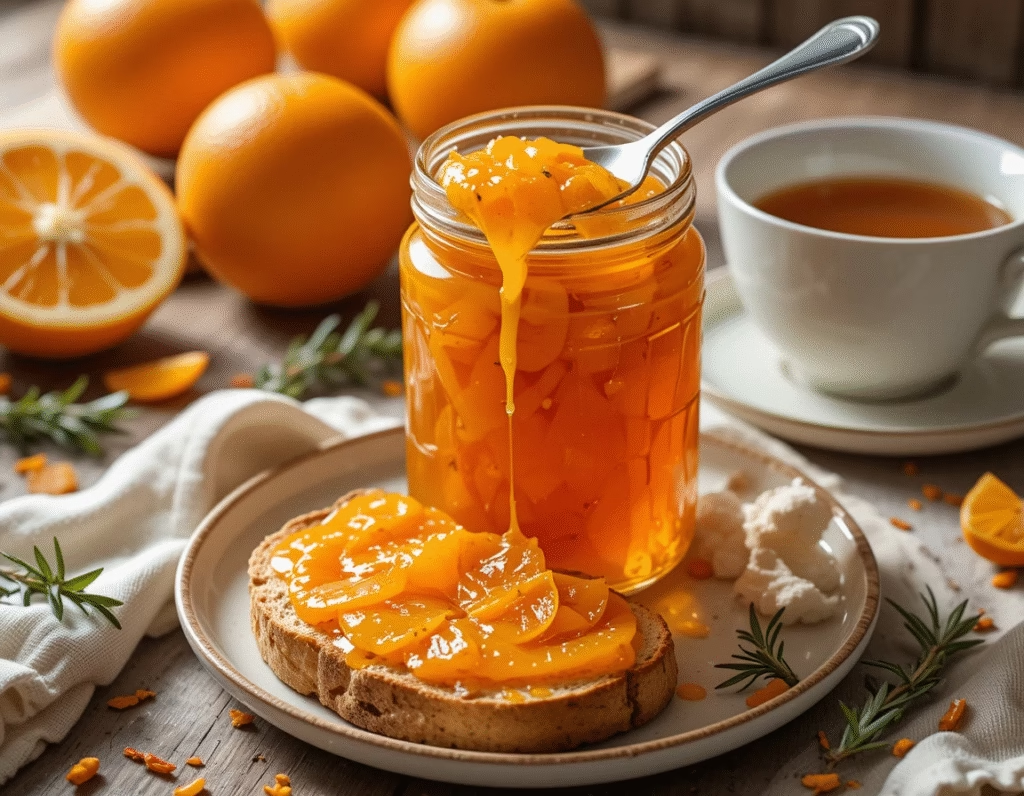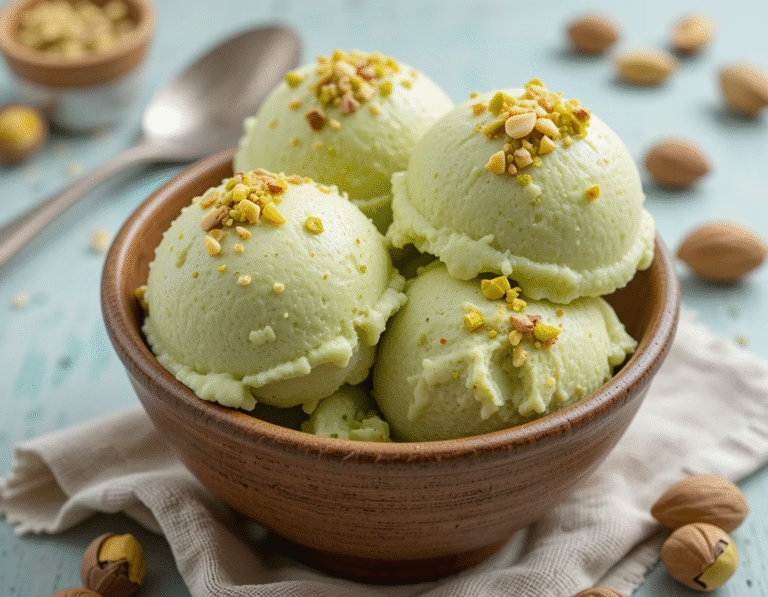Homemade Orange Marmalade Recipe: Sweet & Tangy Delight
Orange Marmalade is a timeless, classic preserve that has delighted taste buds for generations. Known for its vibrant color, slightly bitter citrus flavor, and sweet aroma, Orange Marmalade stands apart as a versatile and delicious addition to breakfasts, snacks, and even savory dishes. This delightful spread combines the zesty brightness of fresh oranges with a perfect balance of sweetness, creating a flavor profile that is both refreshing and comforting.
The tradition of making Orange Marmalade has roots in British culinary history, but it has since become a beloved staple in many American kitchens. Whether spooned over warm toast, dolloped onto scones, or used as a glaze for roasted meats and vegetables, this preserve brings a burst of sunshine to any dish. Its popularity endures because of the natural ingredients and relatively simple preparation process, making homemade Orange Marmalade a satisfying project for any home cook.
Beyond its exquisite taste, Orange Marmalade carries a nostalgic charm, evoking memories of cozy mornings and family gatherings. It’s not just a spread—it’s a sensory experience filled with the scent of fresh citrus, the sparkle of sunshine in a jar, and the warm comfort of home. When you make your own Orange Marmalade, you get to control the sweetness, the thickness, and even add your own twist with spices or additional citrus flavors.
In this blog post, you will find everything you need to know to craft the perfect batch of Orange Marmalade. From essential ingredients and step-by-step instructions to storage tips and common mistakes to avoid, this guide is designed to make your marmalade-making journey enjoyable and successful. Whether you are new to preserving or a seasoned jam maker, this Orange Marmalade recipe will become a favorite go-to that brings a bright, delicious touch to your table all year round.
What You’ll Need
Creating the perfect Orange Marmalade starts with gathering the right ingredients and tools. Using fresh, high-quality produce and proper equipment ensures that your marmalade will have the vibrant color, balanced flavor, and perfect texture that defines this classic preserve.
Ingredients
- 4 large oranges (preferably organic): Fresh, ripe oranges are the heart of your Orange Marmalade. Organic is preferred to minimize pesticides, especially since you will be using the peel. Choose firm oranges with a bright, unblemished skin.
- 2 lemons: The addition of lemons provides natural pectin and acidity, helping the marmalade set beautifully while adding brightness.
- 6 cups water: Used to soften the fruit and extract the flavors and natural pectin during cooking.
- 8 cups granulated sugar: Sugar balances the citrus’s natural bitterness and acts as a preservative. Use pure granulated sugar for the best results.
- Optional: 1 tsp vanilla extract or 1 cinnamon stick for a subtle twist on the classic flavor.
Tools
- Large heavy-bottomed pot or preserving pan: Essential for even heat distribution and preventing burning during the long simmering process.
- Sharp knife and cutting board: For slicing the oranges and lemons into thin strips and removing seeds.
- Wooden spoon or heat-resistant spatula: For stirring your marmalade gently but thoroughly.
- Sterilized glass jars with lids: Properly sterilized jars are crucial for preserving your Orange Marmalade safely and extending shelf life.
- Candy thermometer (optional): Useful if you want to monitor the setting point of your marmalade precisely.
Notes on Ingredients
The key to successful Orange Marmalade lies in the balance of fruit, peel, sugar, and water. The peel provides the characteristic bitterness and pectin necessary for setting. Using fresh, high-quality oranges and lemons maximizes flavor and texture. Removing the seeds is important because they contain excess bitterness that could affect the taste of your marmalade.
By having all ingredients measured and prepared in advance, the cooking process will be smooth and enjoyable. In the next section, you’ll learn how to turn these simple ingredients into a delicious homemade Orange Marmalade with step-by-step instructions.
How to Make (include full measurements)
Making homemade Orange Marmalade is a rewarding process that transforms simple ingredients into a vibrant and flavorful preserve bursting with citrus goodness. Following the steps carefully will ensure your marmalade sets perfectly, balances sweetness and bitterness, and captures the fresh essence of the oranges and lemons used.
Step 1: Prepare the Fruit
Start by thoroughly washing 4 large oranges and 2 lemons to remove any dirt or residue. Using a sharp knife, thinly slice the oranges and lemons, peel and all, into very fine strips — about 1/8 inch thick. The peel is essential for giving the Orange Marmalade its characteristic texture and slight bitterness. Remove and set aside any seeds, as these contain pectin but can impart bitterness if left in the marmalade.
Step 2: Cook the Fruit
Place the sliced fruit strips and removed seeds into a large heavy-bottomed pot or preserving pan. Add 6 cups of water and bring to a boil over medium-high heat. Once boiling, reduce the heat to low and simmer for about 45 minutes to 1 hour, stirring occasionally. This simmering softens the peel and extracts the natural pectin from the fruit.
Step 3: Add Sugar and Boil
After the fruit has softened, remove the seed bag or strain the seeds out. Stir in 8 cups of granulated sugar gradually while stirring until the sugar completely dissolves. Increase the heat to high and bring the mixture to a rapid boil. Boil vigorously, stirring often to prevent burning, for about 15 to 20 minutes, or until the marmalade reaches its setting point.
Step 4: Test for Set
To test if your Orange Marmalade has set, place a small spoonful on a chilled plate and let it cool for a minute. Push the marmalade with your finger — if it wrinkles and doesn’t flood back into the gap, it’s ready. If not, continue boiling and test every few minutes.
Step 5: Optional Flavor Additions
If desired, add 1 teaspoon of vanilla extract or a cinnamon stick during the boiling process to add subtle complexity. Remove cinnamon sticks before jarring.
Step 6: Jar and Seal
Once set, carefully ladle the hot Orange Marmalade into sterilized glass jars, leaving about 1/4 inch headspace. Wipe jar rims clean and seal immediately with sterilized lids. Let the jars cool at room temperature. As they cool, lids will pop down indicating a vacuum seal.
Step 7: Store or Use
Your Orange Marmalade is now ready to enjoy. Store unopened jars in a cool, dark place for up to one year. Once opened, refrigerate and consume within 3-4 weeks for best flavor.
With patience and attention, this Orange Marmalade recipe yields a thick, glossy preserve packed with the bright, slightly bitter flavor that defines classic marmalade. It’s a labor of love that pays off deliciously.

Try serving this with a side of Easy Homemade Mango Chutney
Serving and Storage Tips
Knowing how to serve and store your homemade Orange Marmalade correctly will ensure you enjoy it at its best flavor and texture, while maximizing shelf life and safety.
Serving Suggestions
Orange Marmalade is incredibly versatile. Start your morning by spreading a generous layer on warm toast or freshly baked English muffins. Its bright citrus flavor pairs wonderfully with buttery breads, making breakfast or brunch extra special. For a sophisticated twist, try serving it alongside sharp cheeses like cheddar or creamy brie on a charcuterie board. The marmalade’s balance of sweet and bitter complements savory cheese perfectly.
Beyond toast, use Orange Marmalade as a glaze for roasted chicken, pork, or vegetables. Simply brush it on during the last 10 minutes of cooking to add a shiny, flavorful finish. It also works beautifully in baked goods—fold a spoonful into muffin or cake batter for bursts of citrus flavor or use as a filling for thumbprint cookies.
Storage Tips
Proper storage is essential to keep your Orange Marmalade fresh and safe to eat. Once jars are sealed and cooled, store unopened marmalade in a cool, dark pantry or cupboard away from heat sources. This will help preserve the vibrant color and fresh flavor for up to a year.
After opening, always refrigerate your Orange Marmalade and use within 3 to 4 weeks. To avoid contamination and spoilage, use a clean spoon each time you scoop marmalade from the jar and never dip food directly into the jar.
Additional Tips for Longer Storage
If you want to preserve Orange Marmalade even longer, consider freezing it in airtight containers. Frozen marmalade retains its flavor well for several months. When ready to use, thaw it overnight in the refrigerator.
By following these serving and storage tips, you can enjoy the bright, delicious flavor of your homemade Orange Marmalade anytime. Whether as a simple spread or a flavorful ingredient in cooking and baking, proper handling ensures every jar is a delight from the first spoonful to the last.
Mistakes to Avoid
When making your own Orange Marmalade, avoiding common pitfalls can make the difference between a perfect, flavorful preserve and a disappointing batch. Many first-time marmalade makers encounter similar challenges, but with a bit of awareness and preparation, you can easily avoid these mistakes and enjoy a successful Orange Marmalade every time.
One of the most frequent mistakes is not properly preparing the fruit. The peel is key to a good Orange Marmalade because it provides the bitterness and natural pectin that help the marmalade set. Using thick slices or leaving large chunks of peel can lead to an overly chewy texture or bitterness that overwhelms the spread. Always slice your oranges and lemons thinly and evenly to get the best texture and balanced flavor.
Another error to watch for is not removing the seeds carefully. Orange and lemon seeds contain a high amount of pectin, which is helpful, but they can also add unwanted bitterness. Leaving seeds in the pot while cooking is fine if you tie them up in a muslin bag or a small piece of cheesecloth, so they infuse pectin without affecting flavor. Discard the seeds properly once the cooking is done.
A common issue with Orange Marmalade is not cooking it long enough or boiling at the wrong temperature. Marmalade needs to reach the correct setting point for it to gel properly. Under-cooking will leave a runny spread that won’t set well, while over-cooking can cause the marmalade to become too thick or even burnt. Use a candy thermometer to monitor temperature if possible, aiming for about 220°F (104°C). You can also use the cold plate test to check for a proper set.
Another frequent mistake is rushing the sugar addition. Adding all the sugar too quickly or not stirring it in properly can cause crystallization or a grainy texture in your Orange Marmalade. Gradually incorporate sugar and stir constantly until fully dissolved to ensure a smooth, glossy finish.
Lastly, improper storage can spoil your effort. Always sterilize your jars before filling them with hot marmalade to prevent contamination. Ensure jars seal properly and store unopened jars in a cool, dark place. Once opened, refrigerate and use within a month to maintain freshness.
By keeping these common pitfalls in mind, you can avoid frustration and produce a delightful Orange Marmalade that’s beautifully textured, flavorful, and perfectly set.
Tips and Tricks
Mastering the art of making homemade Orange Marmalade becomes easier and more enjoyable with a few handy tips and tricks that enhance both flavor and texture, making your marmalade stand out.
First, choose your oranges wisely. For the best Orange Marmalade, opt for a mix of sweet and slightly bitter oranges like Seville oranges or a blend of navel oranges with a touch of lemon. This balance creates a complex flavor with that classic marmalade tang. Organic fruit is best since the peel is used extensively.
When slicing the fruit, remove as much of the white pith as possible from the peel without losing the peel itself. The pith can add excessive bitterness that might overwhelm the sweetness. Thin, uniform strips of peel ensure even cooking and a pleasant mouthfeel.
One trick to boost pectin naturally is to include the lemon seeds wrapped in a piece of cheesecloth during cooking. They release pectin, helping your Orange Marmalade set without relying on commercial pectin products.
Adding a pinch of salt can enhance the overall flavor by balancing the sweetness and highlighting the citrus notes. For a twist, consider including spices like cinnamon sticks, star anise, or vanilla beans during simmering. Remove them before jarring for a subtle, aromatic layer that elevates the Orange Marmalade.
To avoid crystallization and keep the marmalade smooth and glossy, stir gently but thoroughly throughout cooking. Rapid boiling without stirring can cause sugar to crystallize on the sides of the pan.
Patience is key. Let your marmalade cool naturally in the jars. Don’t rush to refrigerate immediately after jarring, as this allows the marmalade to develop a proper seal and preserve its freshness longer.
Finally, if you prefer a chunkier marmalade, reduce the cooking time slightly to retain more fruit texture. For a smoother spread, you can use an immersion blender briefly before adding sugar to break down the fruit more finely.
With these tips and tricks, your homemade Orange Marmalade will not only taste amazing but also have the perfect texture and appearance to impress family and friends.

Suggestions
When it comes to enjoying your homemade Orange Marmalade, there are countless ways to get creative and enhance your culinary experience. This classic preserve isn’t just for breakfast toast — it’s a versatile ingredient that adds brightness, sweetness, and depth to many dishes, both sweet and savory.
One popular way to enjoy Orange Marmalade is by spreading it thickly on warm toast, English muffins, or croissants. The vibrant citrus flavor pairs beautifully with butter or cream cheese for an indulgent start to your day. You can also swirl Orange Marmalade into yogurt or oatmeal to add a burst of flavor and natural sweetness, making your morning routine more exciting and nutritious.
In baking, Orange Marmalade is a fantastic addition. Use it as a filling for thumbprint cookies, tarts, or layer cakes. Its tangy sweetness perfectly complements rich flavors like chocolate, almond, or vanilla. Try glazing pound cakes or bundt cakes with a warm marmalade glaze for a shiny, flavorful finish that will impress guests.
Savory dishes also benefit from a touch of Orange Marmalade. Brush it over roasted chicken, pork tenderloin, or salmon during the last minutes of cooking to create a delicious, caramelized glaze. Combine it with mustard or soy sauce for a quick and tasty marinade or dipping sauce. Adding Orange Marmalade to salad dressings or vinaigrettes introduces a fresh, fruity contrast that brightens greens and vegetables.
For gift-giving, homemade Orange Marmalade jars make thoughtful, charming presents. Dress the jars with colorful fabric covers, personalized labels, or ribbons for a personal touch. Share your homemade delight with friends and family, spreading joy through flavor.
You can also experiment with flavor variations by adding different citrus fruits like grapefruit or lime, or spices such as ginger or cardamom, to create your own signature Orange Marmalade blends.
No matter how you choose to serve or use it, Orange Marmalade brings sunshine and zest to your meals and snacks. Keep exploring new ways to enjoy this classic preserve and savor its unique, refreshing flavor every day.
FAQ
What is the best type of orange to use for Orange Marmalade?
The best oranges for Orange Marmalade are slightly bitter varieties like Seville oranges, which provide natural pectin and the classic marmalade flavor. If Seville oranges aren’t available, a mix of navel oranges and lemons works beautifully to balance sweetness and tartness.
How long does homemade Orange Marmalade last?
Unopened jars of Orange Marmalade can be stored in a cool, dark place for up to one year. Once opened, it should be refrigerated and consumed within 3 to 4 weeks for the best flavor and safety.
Can I make Orange Marmalade without added sugar?
Sugar is essential in Orange Marmalade for sweetness, preservation, and helping it set properly. While you can reduce sugar slightly, making it completely sugar-free may result in a marmalade that doesn’t set well and spoils quickly.
Why did my marmalade not set properly?
Improper setting is often due to undercooking or insufficient natural pectin. Make sure to boil the marmalade to about 220°F (104°C) or use the cold plate test. Including lemon and seeds wrapped in cheesecloth during cooking can boost pectin levels.
Can I freeze Orange Marmalade?
Yes, you can freeze Orange Marmalade in airtight containers. It retains flavor well and can be stored frozen for several months. Thaw overnight in the refrigerator before use.
How can I avoid bitterness in my Orange Marmalade?
Remove as much of the white pith as possible when slicing the oranges, as it adds bitterness. Also, avoid using seeds directly in the marmalade; wrap them in cheesecloth to extract pectin without bitterness.

Conclusion
Making your own Orange Marmalade at home is a delightful and rewarding experience that fills your kitchen with the fresh, zesty aroma of citrus and results in a delicious preserve that can brighten up many meals. Whether you are new to preserving or a seasoned home cook, mastering this classic recipe brings the satisfaction of creating something wholesome and flavorful from simple ingredients.
Throughout this journey of crafting the perfect Orange Marmalade, you’ve learned the importance of using the right oranges, slicing them thinly, and carefully balancing sweetness and bitterness. The process of simmering the fruit to extract natural pectin, adding just the right amount of sugar, and testing for the perfect set ensures your marmalade achieves the ideal texture — thick, glossy, and spreadable.
Enjoying your homemade Orange Marmalade doesn’t stop at breakfast. From glazing savory dishes to enhancing baked goods, the versatility of this citrus preserve is vast. You can impress your friends and family by incorporating it in creative ways that showcase its bright, tangy flavor. Plus, sharing jars of your Orange Marmalade as gifts adds a personal touch that celebrates home cooking and tradition.
Proper storage ensures your Orange Marmalade stays fresh and delicious for months, allowing you to savor the fruits of your labor long after the initial batch is made. Remembering key tips, avoiding common mistakes, and experimenting with your own flavor twists will help you refine the recipe and make it uniquely yours.
Ultimately, making Orange Marmalade is about more than just the end product; it’s about the process, the care, and the joy of bringing a timeless preserve into your kitchen. With this recipe, you have a dependable foundation to create luscious, tangy marmalade that celebrates the simple beauty of citrus fruits.
So, gather your oranges, prepare your jars, and embark on this satisfying culinary adventure. Your homemade Orange Marmalade promises to be a bright, flavorful addition to your pantry and a delicious reminder of the joys of cooking from scratch.







